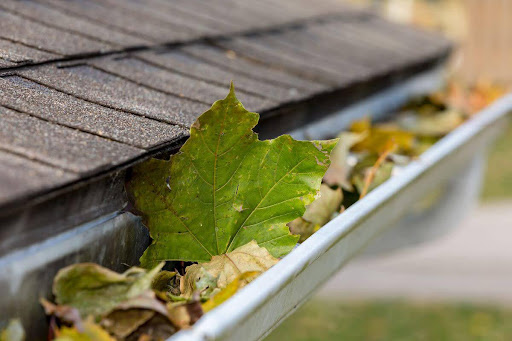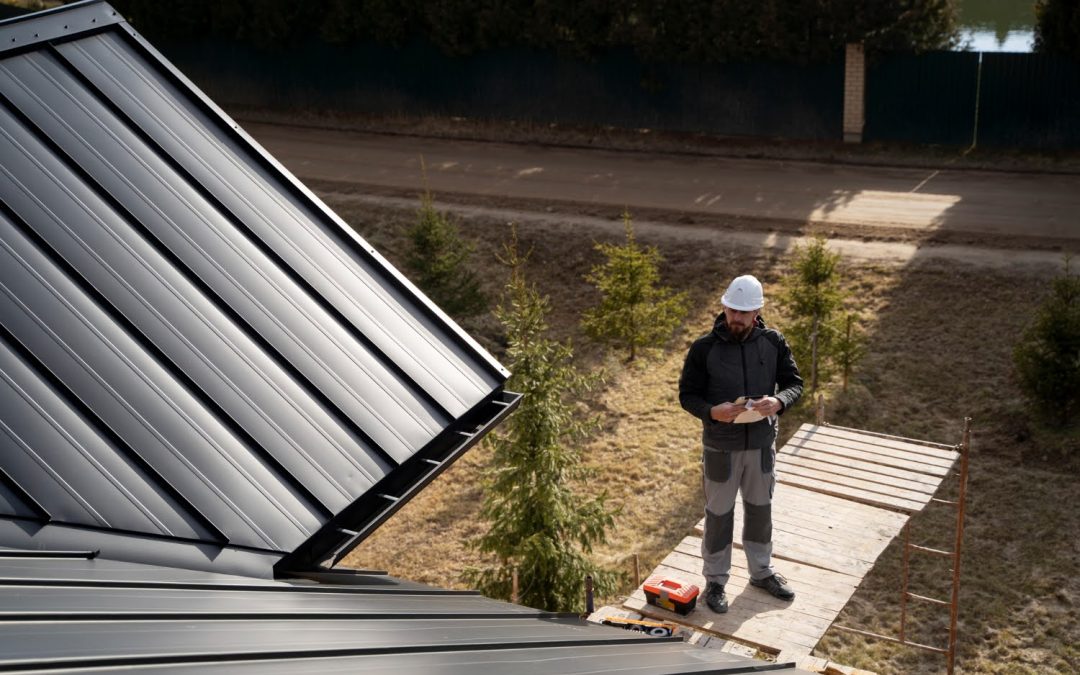Rain gutters play a crucial role in protecting your home from water damage. They direct rainwater away from your foundation, preventing erosion, basement flooding, and other moisture-related issues.
Unfortunately, the weather here in South Jersey can be particularly harsh on these systems. Our region experiences a variety of weather patterns, including powerful storms, heavy rain, and occasional hail, all of which can inflict significant damage on your gutters.
Understanding how to address gutter damage effectively is key to maintaining your home’s integrity and safety. In this post, we’ll explore the impact of stormy weather on gutters and discuss whether replacing or repairing them is better for your home.
Climate Patterns in South Jersey
South Jersey experiences diverse weather conditions, influenced by our geographical location between the Atlantic Ocean and the Delaware River.
In recent years, climate change has begun to alter these weather patterns, with significant implications for storm frequency and intensity. Research conducted by the Department of Environmental Protection indicates that the area is experiencing more intense and frequent weather events, from nor’easters and hurricanes in the fall to severe thunderstorms in the summer. These changes are not just a matter of inconvenience but pose serious risks to residential buildings, particularly to components like rain gutters.
Impact on Residential Structures
Gutters are designed to manage water flow around your home, protecting your foundation, siding, and landscaping from water damage. But the increased frequency of heavy rainstorms means that gutters are now under more strain than ever before. During intense storms, gutters can quickly become overwhelmed, leading to overflow and — in some cases — detachment from the house due to the weight of the accumulated water and debris. Moreover, the impact of hail or strong winds can physically affect your system, leading to a broken gutter with impaired functionality.
Factors Contributing to Storm Resistance
When it comes to protecting your home from the ravages of stormy weather, the resilience of your gutter system plays a pivotal role. Several factors influence how well your gutters can withstand the elements.
Installation Method
The way your gutters are installed significantly impacts their ability to endure harsh weather. Professional gutter installation is crucial for maximizing storm resistance. Experts will ensure that the system is securely fastened to your home’s fascia and that they have the correct pitch, allowing water to flow freely and prevent pooling.
Gutter Material
Choosing the right material for your gutters is another critical decision that affects their performance in adverse weather conditions. Here’s a look at the most common materials used:
- Aluminum: Lightweight and rust-resistant, aluminum gutters are highly popular due to their durability and cost-effectiveness. They can handle most severe weather conditions without corroding.
- Copper: Known for its exceptional longevity and distinctive appearance, copper gutters are sturdy and corrosion resistant. However, copper is generally more expensive than other materials.
- Vinyl: Vinyl gutters are the easiest to install and are quite resistant to rust and corrosion. However, they may become brittle and crack in extremely cold weather, which can be a concern during winters.
- Steel: Extremely sturdy and more resistant to damage from falling branches or hail than aluminum or vinyl. However, steel gutters can rust over time if not properly coated.
Maintenance & Upkeep
Regular maintenance is essential to ensure your gutters can withstand the test of time and weather. Tasks such as cleaning out leaves and debris, checking for rust or cracks, and ensuring that all sections are securely fastened can significantly enhance weather resistance.
Before the storm season, it’s wise to hire a professional to thoroughly inspect and address any issues that could lead to failures during extreme weather. After a storm, you’ll want to have your system checked for signs of gutter damage or blockage.
Identifying Gutter Damage

Gutters are your home’s first line of defense against water damage. Understanding how to identify and address gutter damage from hail, wind, and heavy rain is crucial for maintaining the integrity of your system.
Types of Damage Caused by Inclement Weather
- Dents and Holes: Hail can leave noticeable dents or even puncture holes in metal gutters.
- Sagging or Detached Gutters: Heavy rain can fill gutters with water and debris, causing them to sag or pull away from the house if not properly secured.
- Clogs and Blockages: Leaves, twigs, and other debris can accumulate, especially after a storm, blocking the flow of water and causing overflow.
- Leaks and Cracks: Over time, gutters may develop leaks or cracks, particularly at the seams or joints, which are exacerbated by harsh weather conditions.
Visual inspections will help homeowners spot these issues. Be sure to look for any signs of physical damage or water not draining properly, which could indicate a blockage or a break in the system.
DIY Fixes for Minor Gutter Damage
For homeowners comfortable with ladder work, some issues can be resolved without professional help. Addressing minor gutter damage yourself will save money as well as prevent further issues in the future.
Fixing Leaks
When fixing leaks, it’s essential to apply gutter specific sealant to any cracks or joints where water is leaking. Make sure that the gutter is dry and clean before applying the sealant to ensure it adheres properly; this will create a stronger waterproof barrier.
Clearing Clogs
Start by using a garden hose to flush out debris from the gutters and downspouts. If you encounter more stubborn blockages, a plumber’s snake or a specialized gutter cleaning tool might be necessary to remove the obstruction and restore proper water flow.
Repairing Sagging Gutters
If your gutters are sagging, inspect the gutter hangers for any damage. If the hangers are intact, they may just need to be re-secured to the fascia. However, if the hangers are damaged, replacing them is the best course of action to ensure your gutters remain firmly attached and functional.
Safety Tips to Keep in Mind
Always use a sturdy ladder with a stabilizer. Wearing gloves is crucial to protect your hands from sharp edges and debris. Additionally, be mindful of your positioning on the ladder — never lean over the edge of the gutter, as this can lead to dangerous falls or imbalance. By following these precautions, you can effectively maintain your gutters and prevent significant damage.
When to Call a Professional
While tackling gutter maintenance and minor repairs yourself can be cost-effective, there are circumstances where professional help is necessary. Understanding when to call in the experts will save you from exacerbating the problem, which could lead to more costly repairs later on.
Severe Structural Damage
Gutters that are severely bent or have large sections missing compromise the system’s integrity. Such extensive damage typically requires professional gutter repair or complete replacement. Experts have the tools and expertise to handle any significant structural issues safely and efficiently.
Installation Errors
Sometimes the root of a gutter problem is poor installation. If gutters are not installed correctly, they won’t function as intended, leading to persistent issues such as leaks, overflows, or damage to your home’s exterior. A professional can assess the installation quality and may recommend reinstallation to ensure your gutters perform correctly.
Safety Concerns
Gutter maintenance can be hazardous, especially if your home has multiple stories or a complex roof configuration. If accessing your gutters requires navigating steep slopes or high elevations, the risk of injury is very possible. In such cases, it’s safer to hire professionals who are trained and equipped to handle these challenging environments safely.
To Repair or Replace?
When it comes to gutter damage, one of the critical decisions homeowners face is whether to repair the existing system or replace it entirely. This decision impacts both the functionality of your home’s drainage system and your bottom line. Here are some guidelines to help you make an informed choice!
Assess the Extent of Damage
Start by evaluating how extensive the damage is. Minor issues like small leaks, loose hangers, or isolated sections of sagging gutters can often be repaired easily at a low cost. However, if you notice widespread damage or structural issues, replacement might be the more viable option.
Consider the Age of Your Gutters
The age of your gutters should also play a role in your final decision. Most gutter systems are designed to last 20-30 years, depending on the material. If your gutters are nearing the end of this lifespan, investing in new gutters might be more cost-effective than paying for ongoing repairs.
Check for Recurring Issues
If you find yourself repairing the same problem repeatedly, it might indicate an underlying issue that simple repairs cannot address. In such cases, replacing your gutters may offer a long-term solution.
Cost-Benefit Analysis of Repair vs. Replacement
Generally, repairs are less expensive than a full replacement. They can often be a good option for newer gutter systems with minor damage. However, the costs may add up if repairs become frequent, making it less economical over time.
Conversely, the initial replacement of your gutters is often more costly than repairing them. It’s important to note that new gutter systems offer the advantage of newer materials and technologies that are more durable, potentially saving you money on future maintenance. New gutters can also improve your home’s exterior while increasing your property’s overall value.
New gutter installations often come with a warranty, as well — something that isn’t available with repairs. This warranty provides additional value, ensuring that any future problems are covered without additional expense.
Is Gutter Damage Covered by Homeowner’s Insurance?

Because gutters are an integral part of your home’s roofing, their maintenance and repair are often covered under your policy depending on the cause of damage.
Most standard homeowner’s insurance policies cover gutter damage if it is caused by specific “covered perils” listed in the policy. These typically include unexpected events such as fire, hail, and storms. Even so, damage resulting from wear and tear or lack of maintenance is generally not covered. It’s important to review your policy details or speak with your insurance agent to understand what types of damage are covered, including any exclusions that may apply.
Tips for Filing Insurance Claims
- Report Damage ASAP: As soon as you notice damage to your gutters, contact your insurance company to report the claim. Delaying can complicate the claims process and may lead to further damage.
- Provide Detailed Information: When you file the claim, be as detailed as possible about the extent of the damage and how it occurred. This information can help your insurance adjuster understand the situation and process your claim more efficiently.
- Work with Approved Contractors: Some insurance policies require that repairs be made by approved contractors to qualify for reimbursement. Check with your insurer to see if they have specific requirements for contractors.
- Take Photos and Videos: Document all damage with clear photos and videos. This visual evidence is crucial for supporting your claim and demonstrating the extent of the damage.
- Keep Records of Repairs and Maintenance: Maintain records of any repairs or maintenance done on your gutters. Receipts, invoices, and before-and-after photos can all help prove that you have maintained your gutters properly, which can influence your claim.
- Prepare a Detailed Inventory: List all damaged sections and any associated equipment or property damage. This inventory will be useful during the insurance adjuster’s visit and for ensuring that all damage is accounted for in your claim.
Weather Your Worries with Van’s Rain Gutters!
At Van’s Rain Gutters, we understand the challenges that come with gutter damage and the importance of swift solutions. We are fully licensed and insured, providing peace of mind to all our clients. Whether you need repairs, maintenance, or a complete gutter overhaul, we are here to provide top-notch service tailored to your needs. Trust us to help protect your home from the elements with professional gutter solutions!

